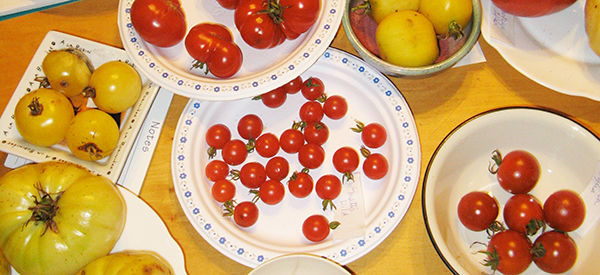Tomato plants first appeared in print in 1595 in Spain. Tomatoes were erroneously thought to be poisonous.
Earlier around 1521 Cortes was known to have distributed the tomato to the Caribbean, Philippines, and southeast Asia.
In Italy, the tomato was thought of more as an ornamental vine rather than an eating fruit. So it was a hanging vine and the vines were usually named after the region that they were grown in. We have grown such a vine called Principe Borghese.
In Britain, the tomato appeared around 1590. By mid 18th. century it appeared in Encyclopedia Britannia. Again the tomato was mostly referred to and enjoyed by the appearance of the fruit.
The use of cooking was associated with Italian and Jewish cuisine.
Tomatoes are now the most common garden fruit. About 161.8 million tonnes were produced world-wide in 2012. Tomato production was valued at 58 billion dollars. China is now the largest producer followed by India and the United States.
California produces about 90% of US production.
Tomatoes are the 8th most valued agriculture products today there are many commercial varieties grown. However, they do not have the flavour and lack the sugar content. These poorer cousins are the result of breeding to obtain uniformity. To produce a red fruit without the typical green ring around the stem which most heirloom tomatoes have. Commercial growers wanted a consistent size, shape, disease and pest resistance, suitable for mechanized picking and hardy for shipping. The consumer wanted red, round, no blemishes, and hardy to keep in the fridge. Another words perfection.
Tomato plants are either determinite or indeterminate.
Determinite is a bush type, a full crop ripens all at once. The Determinate variety is preferred by commercial growers who wish to harvest a whole field at one or it could be a home grower who is interested in canning. They are often good choices for container growing.
Indeterminite develops into a vine which continues to produce until frost. These are preferred if you want ripe fruit throughout the season. So the fruit ripens a few at a time and as they grow up the vine. The majority of heirlooms are indeterminate.
Today’s cultivars can be green, yellow, orange, pink, black, brown, ivory, white, or purple.
A rule to remember about the tomato plant you will be buying is this. If you have a short summer than you should pick a variety that is early and if you are fortunate to have a long summer than you can also pick a variety that is late. You can have the pleasure of both.
Your choice if you want small, medium, or large size. I have a small one like a cherry tomato for when I am in the garden and like nothing better than to pick one and pop it into my mouth.
Our choice is also mostly medium. One tomato goes a long way for two people. A beefsteak tomato, which is huge; is too much for us. Most of the medium varieties when sliced cover a hamburger bun quite nicely.
The tomato is eaten freely throughout the world today.
Carotene Lucopene is one of the most powerful natural antioxidants contained in the tomato. Tomato research is still going on all over the world.
There are varieties out there that have: double the normal Vitamin C, 40 times the normal Vitamin A and 4 times normal lycopene. Proper storage of the tomato is to store unwashed.
Photo by Suzi Gabany – The Tomato Lady – HeritageTomatoes

